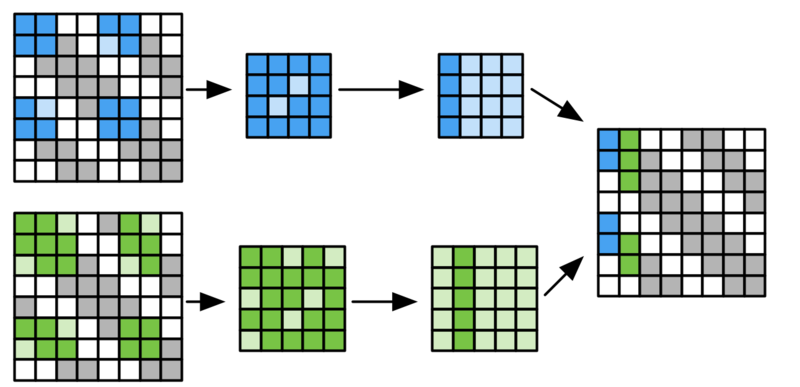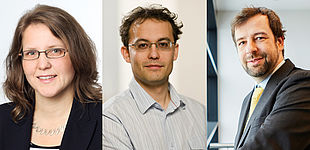Exact results with inexact computations: Prof. Plessl and Kühne receive Paderborn University Research Award
According to recent estimations, IT systems consume about 15% of the global electrical power. Due to the continuing exponential growth of computing systems, there is a strong economic and ecologic interest to increase their energy-efficiency. How this goal can be achieved is demonstrated by the computer scientist Prof. Dr. Christian Plessl and the theoretical chemist Prof. Dr. Thomas D. Kühne with their interdisciplinary research project, which is supported by the executive board of Paderborn University with an award of 150,000 Euro. → READ MORE
Massively Parallel Computation of Approximate Inverse Roots for Large Sparse Matrices
Our Submission “A Massively Parallel Algorithm for the Approximate Calculation of Inverse p-th Roots of Large Sparse Matrices” has been accepted for publication at the Platform for Advanced Scientific Computing (PASC) conference, taking place in July 2018 in Basel, Switzerland. The paper is the result of combined effort by members of the Departments of Computer Science and Chemistry at Paderborn University, the Paderborn Center for Parallel Computing and the Barcelona Supercomputing Center.
→ READ MORE
Efficient Computation of Inverse Matrix Roots
Our article A General Algorithm to Calculate the Inverse Principal p-th Root of Symmetric Positive Definite Matrices has been accepted for publication in the Communications in Computational Physics (CICP). This article is a joint work by the research groups of three PC² board members from the Departments of Chemistry, Computer Science and Mathematics. In the article, we describe an iteration scheme for the calculation of inverse roots of matrices and prove and analyze its convergence under specific conditions. The proposed method allows trading of the number of iterations required to obtain a result against the computational effort within each iteration. → READ MORE
Decision of the Joint Science Conference (Gemeinsame Wissenschaftskonferenz, GWK) for a high-performance computer at Paderborn University
Following the recommendation by the German Council for Science and Humanities (Wissenschaftsrat), the Joint Science Conference (Gemeinsame Wissenschaftskonferenz, GWK) has decided on June 23 to approve funding for a new high-performance computer at Paderborn University. The Council for Science and Humanities had issued a recommendation with best ratings for the proposal of Paderborn University for a new high-performance computer in May. → READ MORE
The German Council for Science and Humanities (Wissenschaftsrat) recommends funding for a high-performance computer at Paderborn University: 25m€ for Noctua and a new computing center – ensuring sustained development of computational sciences
The German Council for Science and Humanities has issued a funding recommendation with the highest ranking for the proposal of Paderborn University for a new high-performance computer. Between 2018 and 2022, the federal government, the state government of North Rhine-Westfalia and Paderborn University will provide a total of 25.4 million €. In two phases, a total of 10 million € will be invested in a new high-performance computer, which – presumably – will rank among the ten most powerful HPC systems in Germany when taken into operation. -> READ MORE
Protons hop from one water molecule to another given suitable energy conditions
Protons, as positively charged hydrogen ions, move very rapidly in water from one water molecule to the next, which is why the conductivity of water is relatively high. The principle of proton conduction in water has been known for 200 years and is named the Grotthuss mechanism after its discoverer, Theodor Grotthuss. It is based on the assumption that it is not that a single specific proton moving from one molecule to another; instead, there is cleavage of bonds. One proton docks onto a molecule and this causes another proton to leave that molecule and bind to another molecule somewhere else. → READ MORE
Mainz scientists confirm original tetrahedral model of the molecular structure of water
Researchers at Johannes Gutenberg University Mainz (JGU) have confirmed the original model of the molecular structure of water and have thus made it possible to resolve a long-standing scientific controversy about the structure of liquid water. The tetrahedral model was first postulated nearly 100 years ago and it assumes that every water molecule forms a so-called hydrogen bond with four adjacent molecules. This concept was almost toppled in 2004 when an international research group announced that it had experimentally established that water molecules form bonds only with two other molecules. → READ MORE
How diamonds emerge from graphite
The contrast between the naturally occurring forms of elemental carbon – as grey-black graphite or sparkling diamond – is greater than for almost any other material. The substantial difference between the two forms is mainly due to their crystal structure, which is cubic in the case of diamond and hexagonal for graphite. This gives rise to the different properties of the two materials and makes diamond the hardest known material, alongside the comparatively soft graphite. This is why diamonds are not only in demand as an attractive gemstone but are also important as an industrial tool, e.g. for grinding or sawing. → READ MORE








